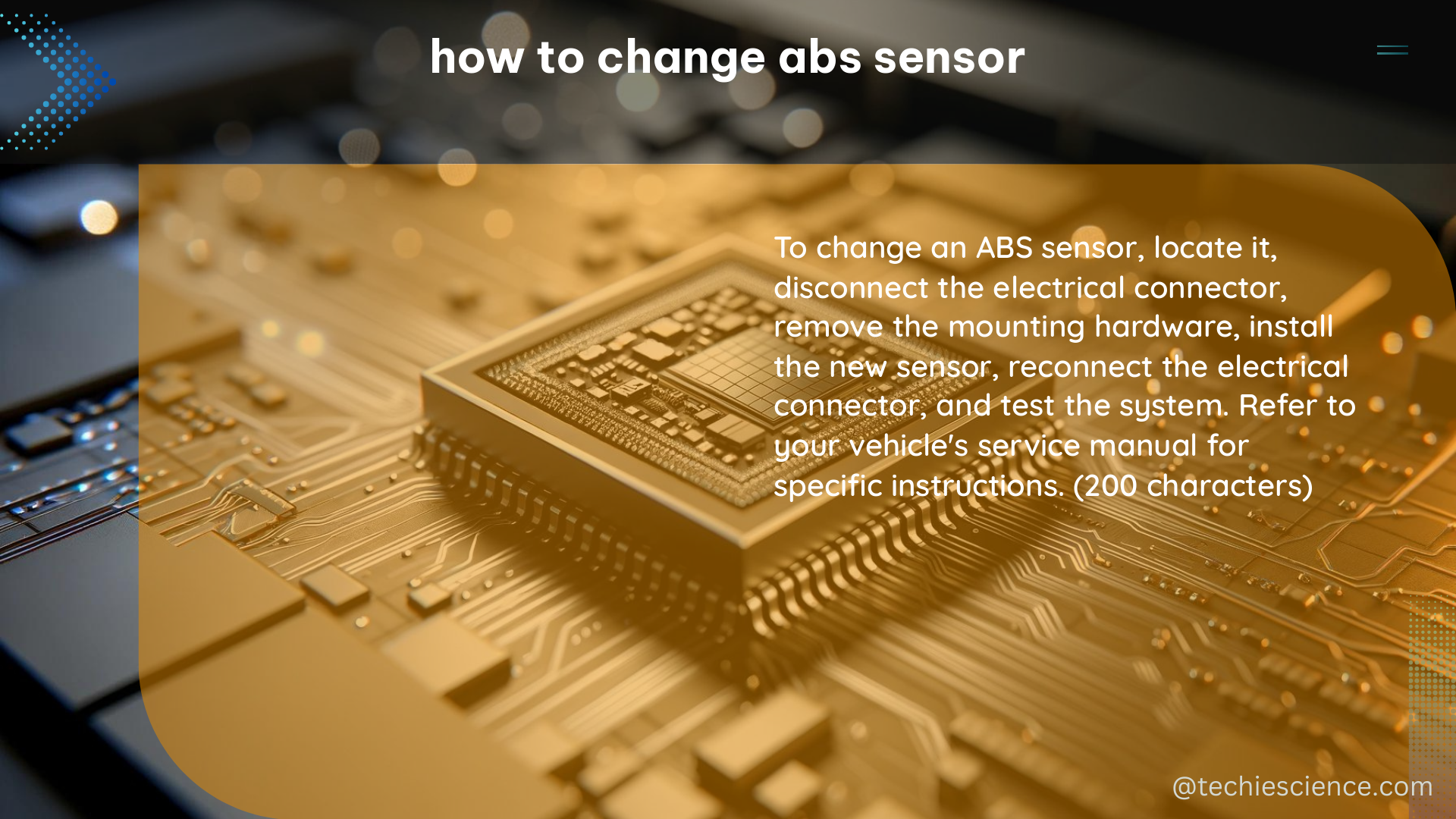Changing an ABS (Anti-lock Braking System) sensor is a crucial maintenance task that can help ensure the proper functioning of your vehicle’s braking system. This comprehensive guide will walk you through the step-by-step process of replacing an ABS sensor, providing detailed information on the key measurable and quantifiable data points to consider for a successful installation.
Understanding ABS Sensor Types and Specifications
Before diving into the replacement process, it’s essential to understand the different types of ABS sensors and their specifications. There are two primary types of ABS sensors:
- Passive Sensors: Passive sensors output an alternating current (AC) voltage frequency signal. They typically have two wires and require a minimum wheel speed of 1-2 mph to generate a signal.
- Active Sensors: Active sensors create a square wave digital signal. They usually have three wires and can detect wheel speed from a standstill.
When replacing an ABS sensor, it’s crucial to ensure that the new sensor matches the type and specifications of the original. This includes checking the following data points:
Resistance Values
For passive-style wheel speed sensors, you can measure the resistance of the ABS sensor using a digital multimeter (DMM) set to the ohms setting. The resistance value should fall within the range specified in the repair manual or repair database for your vehicle. Typical resistance values for passive ABS sensors range from 800 to 2,000 ohms.
Frequency and Amplitudes
The frequency and amplitudes of the alternating voltage induced in the winding of an inductive-passive sensor are directly related to the wheel speed. These values can be measured using an oscilloscope or a digital multimeter (DMM), although the results may be less accurate with a DMM. Typical frequency ranges for passive ABS sensors are between 4 and 400 Hz, with amplitudes ranging from 0.2 to 12 volts.
Connector Type and Wiring
Ensure that the new ABS sensor has the same electrical connector and wiring configuration as the original. This includes the number of wires, wire colors, and any additional features like shielding or grounding.
Preparing for ABS Sensor Replacement

Before you begin the replacement process, gather the necessary tools and safety equipment:
- Safety glasses
- Ratchet and socket set
- Torque wrench
- Digital multimeter (DMM)
- Scan tool or code reader
Additionally, make sure to have the following information on hand:
- Manufacturer’s specifications for the ABS sensor, including resistance values, frequency ranges, and torque specifications
- Repair manual or factory service information for your specific vehicle
ABS Sensor Removal
- Disconnect the negative battery cable to prevent any electrical shorts or damage during the replacement process.
- Safely raise and support the vehicle using a jack and jack stands. Set the parking brake and chock the rear wheels to prevent the vehicle from moving.
- Locate the ABS sensor, which is typically mounted near the wheel hub or brake assembly.
- Disconnect the electrical connector from the ABS sensor harness.
- Use a ratchet and socket to remove the ABS sensor retaining bolt. If there are any additional fasteners holding the sensor’s wiring harness in place, remove them as well.
- Carefully remove the ABS sensor from the vehicle.
ABS Sensor Installation
- Compare the new ABS sensor to the old one to ensure they are the same design and specifications.
- Clean the mounting surface and ensure it is free of any debris or corrosion.
- Install the new ABS sensor, making sure it is properly aligned and seated in the mounting location.
- Reinstall the ABS sensor retaining bolt and any wiring harness fasteners. Use a torque wrench to tighten the bolt to the manufacturer’s specified torque value, typically between 8-20 Nm (6-15 ft-lbs).
- Reconnect the electrical connector to the ABS sensor harness, ensuring a secure and tight connection.
- Carefully lower the vehicle and remove the jack stands.
- Reconnect the negative battery cable.
- Use a scan tool or code reader to clear any related diagnostic trouble codes (DTCs) that may have been set during the sensor replacement.
Verifying ABS Sensor Operation
After completing the installation, it’s essential to verify the proper operation of the new ABS sensor. This can be done by:
- Performing a visual inspection to ensure the sensor is securely mounted and the electrical connector is properly seated.
- Using a digital multimeter to measure the resistance of the sensor, ensuring it falls within the manufacturer’s specified range.
- Checking for any diagnostic trouble codes (DTCs) related to the ABS system using a scan tool or code reader.
- Test-driving the vehicle at various speeds to ensure the ABS system is functioning correctly and the warning lights are not illuminated.
By following these detailed steps and paying close attention to the measurable and quantifiable data points, you can successfully replace an ABS sensor and ensure the proper operation of your vehicle’s braking system.
References
- Hella-Pagid ABS Sensor Technical Information
- Delphi Guide on How to Replace an ABS Sensor
- CarParts.com Article on ABS Sensor Replacement

The lambdageeks.com Core SME Team is a group of experienced subject matter experts from diverse scientific and technical fields including Physics, Chemistry, Technology,Electronics & Electrical Engineering, Automotive, Mechanical Engineering. Our team collaborates to create high-quality, well-researched articles on a wide range of science and technology topics for the lambdageeks.com website.
All Our Senior SME are having more than 7 Years of experience in the respective fields . They are either Working Industry Professionals or assocaited With different Universities. Refer Our Authors Page to get to know About our Core SMEs.